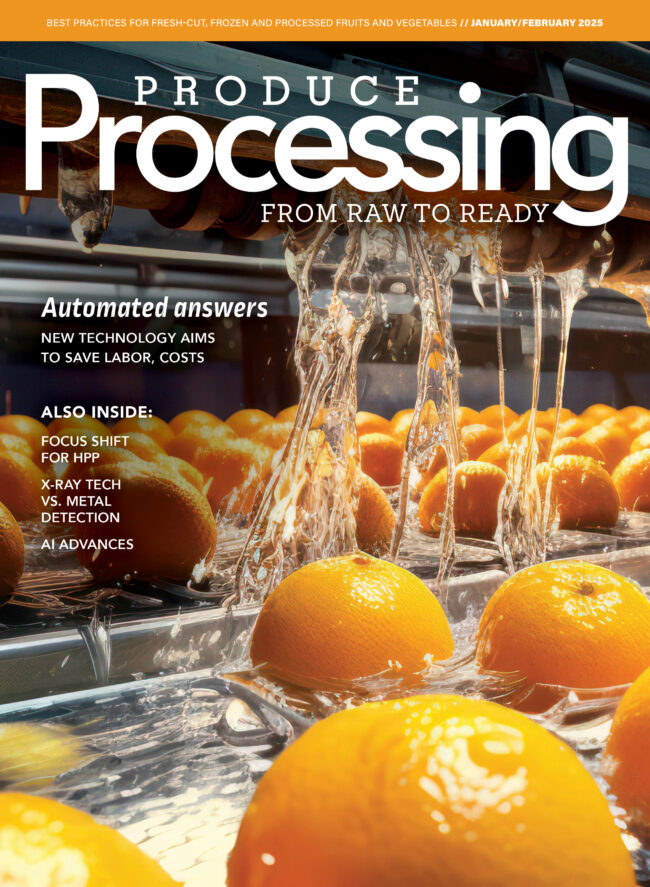Defect details: Metal detection vs. X-ray
Metal detection and X-ray inspection offer differing capabilities. Although both inspection solutions can detect metal contaminants, X-ray inspection offers greater capabilities for foreign body detection and quality assurance.
At high line speeds, X-ray machines can also detect bone, glass, stone and high-density plastics and rubber compounds while simultaneously conducting quality checks such as mass measurement, fill level verification and identification of missing or broken products.
Products with high salt or moisture content can produce a product effect that causes false readings on a metal detector, leading to more false rejects. Higher reject numbers mean more labor is needed for rework, which adds strain to already tight resources.
To overcome this challenge, manufacturers often reduce a metal detector’s sensitivity to enable the majority of products to pass through without false triggering. However, lowering the sensitivity of a metal detector increases the risk of contaminants going undetected and ending up in the final product. An X-ray machine is not affected by temperature, moisture or salt content, so it provides more accurate metal detection levels.
As with any investment, cost is an important factor. The cost of an inspection system includes the ongoing expenditure incurred during the lifetime of the machine. An in-depth evaluation should be undertaken when selecting an inspection solution.
METAL DETECTION CAPABILITIES
Industrial metal detectors have been in existence since the 1960s and are used by food manufacturers at critical control points (CCPs) in many production processes where a hazard analysis and critical control points (HACCP) audit has identified the risk of metal contamination.
Modern metal detectors can identify all metals, including ferrous, non-ferrous, magnetic and non-magnetic stainless steels. Systems can be installed to inspect incoming raw materials prior to processing, at numerous other points in the manufacturing process, or at the end of the production or packing line.
Metal detection is used to inspect a variety of different applications, including loose, unpackaged products; pumped products such as liquids, pastes and slurries; bulk powders and free-flowing solids under gravity-fall conditions; and packed products. The technology is also used to inspect tall, rigid containers such as bottles, jars and composite containers, although inspection must take place before metal caps or closures are applied.

HOW DOES AN METAL DETECTOR WORK?
Metal detectors consist of three coils wound onto a coil former. Each coil is equidistant from the other two. The center coil, known as the transmitter, is energized with a high- frequency electric current that generates a magnetic field.
The two coils on either side of the center coil act as receivers.
Since these two coils are identical in size and the same distance from the transmitter, an identical voltage is induced in each. When the coils are connected in opposition, these voltages cancel out, resulting in zero output.
Products are passed through the coil former, more commonly known as the metal detector aperture. When a metal object passes through the aperture, it disturbs the magnetic fields of both the receiver coils by slightly different amounts. This is detected by a change in the balance condition and interpreted as a metal contaminant.
Metal exposed to such an alternating magnetic field will create an eddy current (a small amount of current induced into the metal due to its ability to conduct electricity), which alters the total magnetic field and leads to a further difference in voltage induced into the receiver coils. The difference in the voltages is what triggers detection.
Although the voltage change is very small, it is enough to be detected and interpreted by sophisticated electronic circuitry and advanced software algorithms. Software generates an electronic signal that can be used to raise
an alarm and activate an automated product rejection mechanism to remove the contaminated product from the production process. Alternatively, the signal can be used to stop the production process by deactivating the conveyor or other packaging or processing machine.
Products with high salt or moisture content can produce a phenomenon known as product effect, when a product’s characteristics affect the metal detector in the same way as a metal contaminant, causing unwanted false readings.
Metalized film packaging also creates a product effect for metal detectors. This is because the relatively high conductivity of the thin layer of aluminum film allows for the formation of eddy currents that generate a detectable magnetic field.
Variations can be difficult to control on a production line, so metal detector sensitivity is often reduced.
X-RAY ALTERNATIVE
X-ray equipment, which first appeared on production lines in the late 1980s, is capable of detecting a wider range of contaminants than metal detectors, including metal, glass, mineral stone, calcified bone, high-density plastics and rubber compounds.
X-rays belong to the group of gamma rays, which are one of several naturally occurring sources of radiation and are an invisible form of electromagnetic radiation like radio waves. All types of electromagnetic radiation are part of a single continuum known as the electromagnetic spectrum.
The spectrum is arranged according to frequency and wavelength and runs from radio waves at one end (which have a long wavelength) to gamma rays (short wavelength) at the other. The short wavelength of X-rays enables them to pass through materials that are opaque to visible light, but they do not pass through all materials with the same ease. The denser the material, the fewer X-rays that pass through. Dense contaminants like glass, calcified bone and metal show up because they absorb more X-rays than the surrounding product.
X-ray systems capture grayscale images of products passing through. The image is analyzed, compared to a predetermined acceptance standard and accepted or rejected. In the case of a rejection, the software sends a signal to an automatic reject system that removes the product from the production line.
There are three key components of an X-ray inspection system: an X-ray generator, a detector and a computer.
After leaving the exit window of the X-ray generator, the X-ray beam travels in a straight line through a collimator, through the product and onto the detector to create the grayscale image.
To accommodate larger products, the X-ray generator has to be moved further away to create a beam wide enough to inspect the whole product. However, increasing the distance between the generator and detector reduces the system sensitivity.
The amount of X-ray energy absorbed during a beam’s passage through a product is determined by product thickness, product density and its atomic mass number. The absorption is known as the linear attenuation coefficient.
When a pack or product passes through the X-ray beam, the X-ray photons are absorbed by the pack or product, with only the residual energy reaching the detector. Measurement of the differences in X-ray beam absorption between product and contaminant is the basis of X-ray inspection.
Usually, food products contain compounds made from elements with an atomic mass of 16 and under — mainly hydrogen, carbon and oxygen. The absorption of X-rays by food products containing low-mass elements is proportional to their density and thickness. In other words, the thicker or denser the product, the more X-rays it absorbs.
A potential contaminant becomes detectable by an X-ray system if it has a high atomic mass. Some contaminants, such as mineral stone or glass, may contain trace amounts of elements with very high atomic numbers. These elements have a multiplying effect on the contaminant’s X-ray absorption.
Food products generally contain low atomic mass elements and have low density, while contaminants usually contain high atomic mass number elements and have a higher density. For this reason, it is convenient to use density as the benchmark for contaminant detection.
In general, contamination detection is only possible where contaminants are denser (i.e. they have higher specific gravity) than the food product in which they are embedded. This means that low-density contaminants such as insects, wood
and polyethylene film cannot normally be detected effectively by X-ray technology.

EXAMINING X-RAY BENEFITS
X-ray systems are capable of inspecting food in a wide range of formats, from unpackaged raw, bulk-flow (loose) and pumped products, to those in a variety of packaging, including glass jars, bottles and metal cans.
In contrast to metal detection, conductive foods (foods that are salty, acidic or have high moisture content) pose no challenges for X-ray inspection systems in any size or format. For example, seafood meats have conductive properties that can mimic a foreign object. This high product effect causes excessive false rejects. X-ray inspection sensitivity is not affected by temperature, moisture or salt content. Additionally, accuracy is not affected by frozen or thawing foods.
X-ray inspection detects other foreign body contaminants, including bone, in a variety of meat, poultry and seafood products at higher line speeds with a lower false reject rate.
Several factors affect sensitivity of contaminant detection:
- Type of product: Homogeneous packs are the easiest type of product to inspect because of the product consistency. However, many food packs comprise
areas of varying absorption caused by variable product amounts, gaps or air pockets, which affects detection. - High density variations: Some foods, such as granola with clusters of fruit, contain high variations in density. Finding physical contaminants in these products can prove challenging for traditional single energy detectors as the varying densities create “busy” X-ray images. However, systems equipped with dual energy X-ray technology can discriminate materials by their chemical composition.
- Thickness/depth: As the density and thickness of the product increases, more X-ray energy is required to penetrate or pass through it. Increasing the X-ray penetration power (kV) reduces the contrast created by the contaminant which, in turn, reduces sensitivity.
- Speed of line: As production line speed increases, the signal-to-noise ratio also increases due to less integration time on the detectors. Faster lines require more X-ray energy or larger detector pitch.
INDUSTRY STANDARDS
As well as helping manufacturers comply with HACCP and retailers’ own specifications, X-ray inspection systems can help food manufacturers achieve certification to a number of Global Food Safety Initiative (GFSI)-recognized schemes, including Safe Quality Food (SQF) 2000 Code and BRCGS. By incorporating features such as validation mode for unique login credentials and XML files for data storage that help to support the audit process, X-ray systems can help food manufacturers meet the rigorous requirements necessary to achieve SQF and BRCGS certification.
Furthermore, X-ray systems allow manufacturers to save and export valuable production data, as well as save rejected product images for off-line review. Images are tagged with the product name, date, time and reason the product was rejected.
By tracking production in this manner, X-ray systems enhance product traceability and provide manufacturers with due diligence capabilities.
Christy Draus is Eagle Product Inspection’s head of marketing.
Editor’s note: This is the first of a two-part series examining the benefits of metal detection and X-ray inspection. Part II will delve deeper into X-ray technology.










